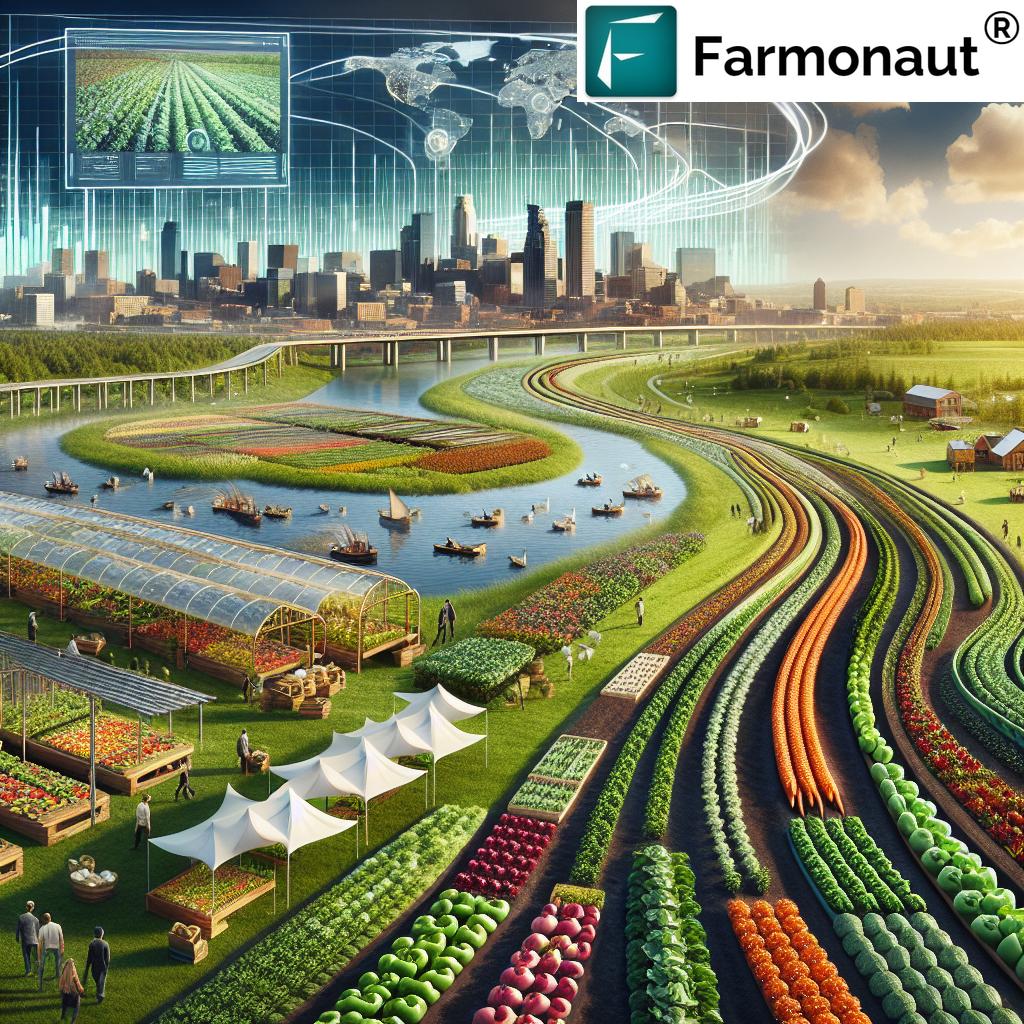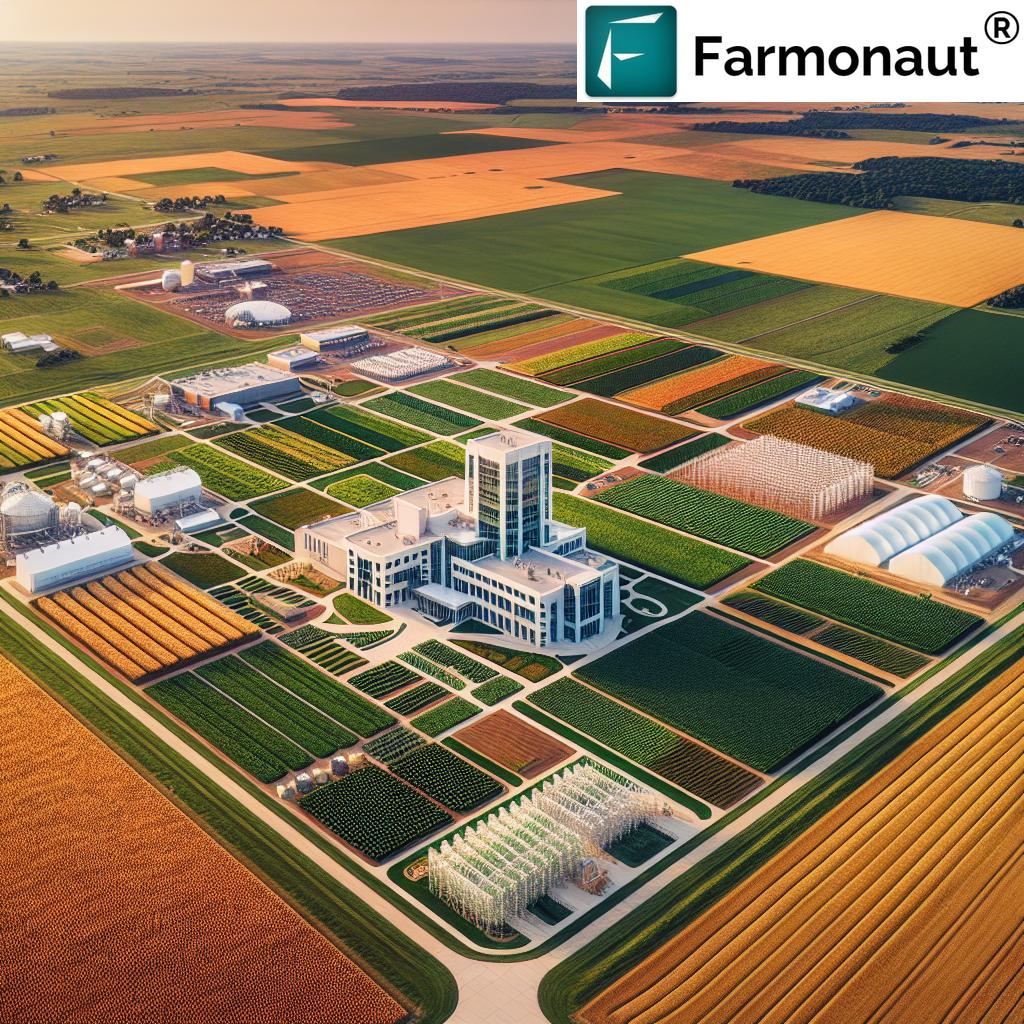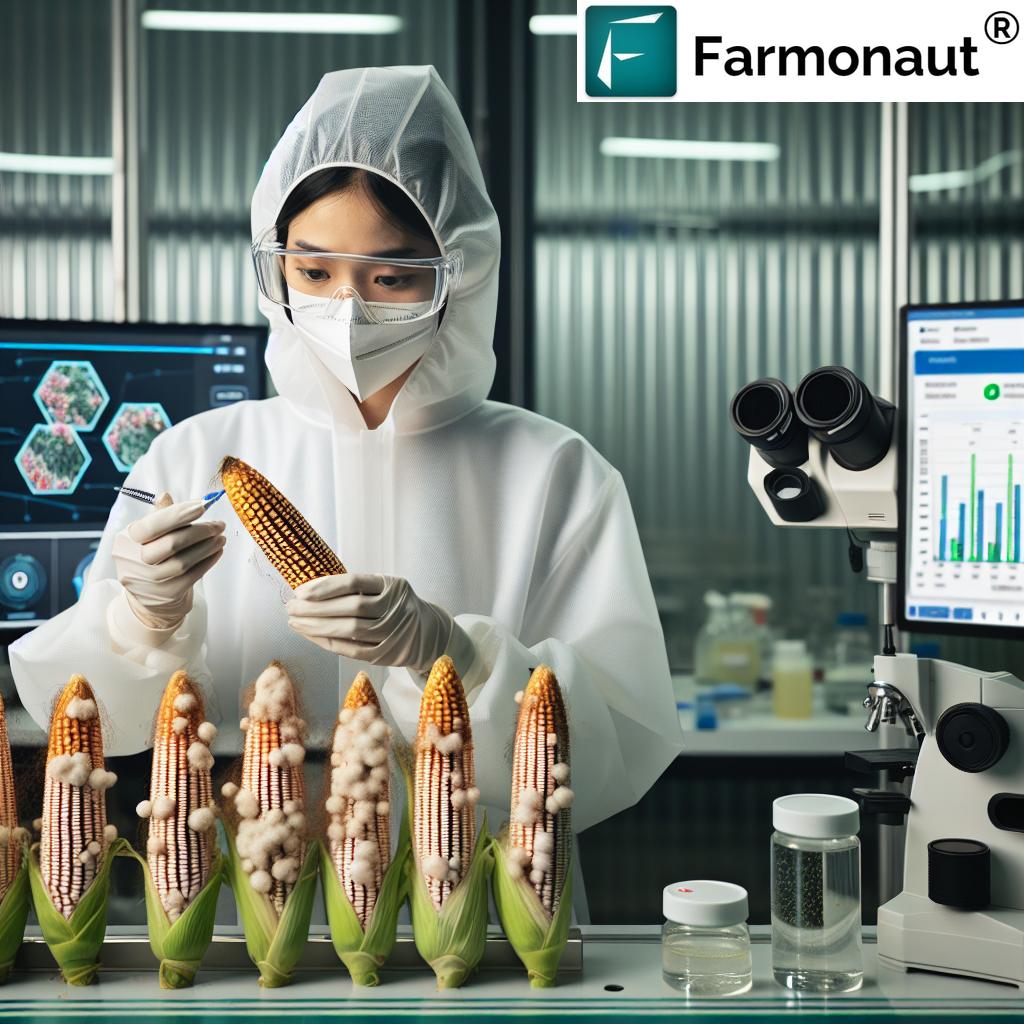USDA’s Groundbreaking Plan: Boosting Sustainable Agriculture and the US Bioeconomy
“The USDA’s new plan aims to boost the US bioeconomy, which is projected to reach $1 trillion by 2030.”
In an era where sustainability and innovation are paramount, we’re witnessing a transformative shift in American agriculture. The United States Department of Agriculture (USDA) has unveiled a groundbreaking plan that promises to revolutionize the agricultural landscape and propel the nation’s bioeconomy to new heights. This comprehensive initiative intertwines sustainable agriculture practices with cutting-edge precision agriculture technology, creating a robust framework for a thriving, eco-friendly future.
As experts in remote sensing and agricultural science, we at Farmonaut are excited to delve into the intricacies of this visionary plan. Our mission to make precision agriculture accessible aligns perfectly with the USDA’s goals, and we’re eager to explore how these developments will shape the future of farming across America.
The Rise of the US Bioeconomy: A New Era for Agriculture
The bioeconomy, a sector that harnesses biological resources to produce food, energy, and materials, is poised for explosive growth. With the USDA’s strategic focus, we’re seeing a concerted effort to position the United States at the forefront of this burgeoning industry. But what does this mean for farmers, ranchers, and rural communities across the nation?
- Increased demand for biomass and biobased products
- New market opportunities for agricultural producers
- Job creation in rural areas
- Advancement of sustainable farming practices
The USDA’s plan is not just about boosting production; it’s about creating a sustainable, circular bioeconomy that benefits both the environment and rural economies. By focusing on biobased product manufacturing and establishing resilient biomass supply chains, the initiative aims to create a symbiotic relationship between agricultural production and environmental stewardship.
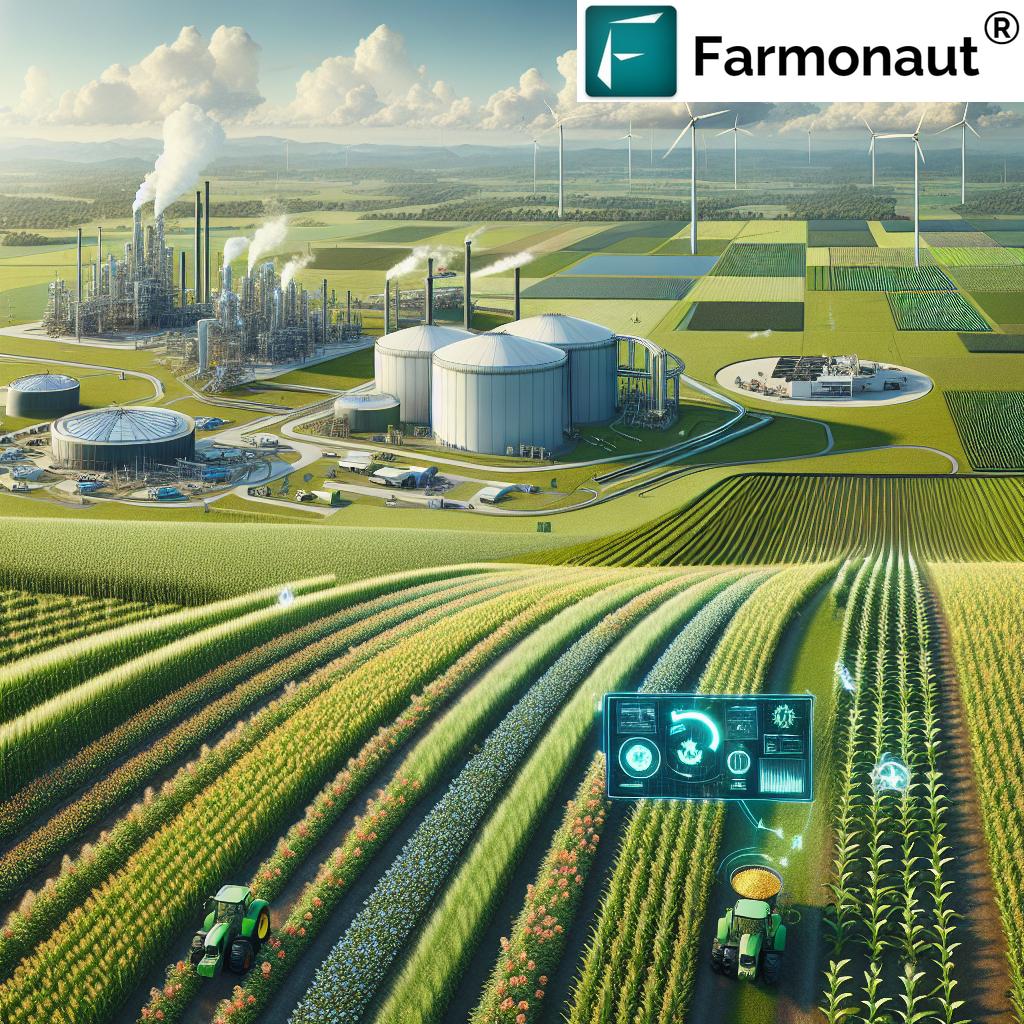
Sustainable Agriculture Practices: The Foundation of Growth
At the heart of the USDA’s plan lies a commitment to sustainable agriculture practices. These methods not only reduce the environmental impact of farming but also improve soil health, water conservation, and overall crop yields. Let’s explore some of the key practices being promoted:
- Cover Cropping: Planting cover crops between harvests to prevent soil erosion and improve soil fertility.
- No-Till Farming: Minimizing soil disturbance to maintain soil structure and reduce carbon emissions.
- Precision Nutrient Management: Using data-driven approaches to apply fertilizers more efficiently, reducing waste and runoff.
- Integrated Pest Management (IPM): Employing biological controls and targeted interventions to manage pests while minimizing chemical use.
These practices not only benefit the environment but also contribute to the long-term viability of farms. By reducing input costs and improving soil health, farmers can enhance their profitability while contributing to a more sustainable agricultural sector.
At Farmonaut, we understand the importance of these sustainable practices. Our satellite-based crop health monitoring system provides farmers with real-time data on vegetation health, soil moisture levels, and other critical metrics. This information empowers farmers to make informed decisions about irrigation, fertilizer usage, and pest management, aligning perfectly with the USDA’s vision for sustainable agriculture.
Precision Agriculture Technology: Revolutionizing Farming
The USDA’s plan heavily emphasizes the role of precision agriculture technology in driving the bioeconomy forward. This cutting-edge approach uses data, analytics, and smart machinery to optimize farm operations. Here’s how precision agriculture is transforming the industry:
- Satellite imagery for crop monitoring and yield prediction
- GPS-guided tractors for precise planting and harvesting
- Drone technology for targeted pesticide and fertilizer application
- IoT sensors for real-time soil and crop health monitoring
These technologies not only improve efficiency but also contribute to sustainability by reducing waste and optimizing resource use. Farmonaut’s platform is at the forefront of this revolution, offering farmers access to satellite-based insights that were once only available to large agribusinesses.
Explore Farmonaut’s precision agriculture solutions:
Building Resilient Biomass Supply Chains
A key component of the USDA’s strategy is the development of robust biomass supply chains. Biomass, which includes agricultural residues, forestry byproducts, and dedicated energy crops, serves as a renewable feedstock for various biobased products. The plan aims to:
- Increase biomass production across diverse agricultural regions
- Improve logistics and transportation networks for efficient biomass distribution
- Develop storage solutions to ensure year-round availability of biomass
- Encourage the adoption of energy crops that complement existing agricultural systems
By strengthening these supply chains, the USDA is laying the groundwork for a thriving bioeconomy that can reliably produce everything from biofuels to bioplastics. This not only creates new markets for farmers but also reduces dependence on fossil fuel-based products.
Boosting Biobased Product Manufacturing
The USDA’s plan places a strong emphasis on expanding biobased product manufacturing. These products, made from renewable biological materials, offer sustainable alternatives to petroleum-based goods. The initiative aims to:
- Incentivize research and development of new biobased materials
- Support the scaling up of biomanufacturing facilities
- Promote the use of biobased products in government procurement
- Educate consumers about the benefits of biobased alternatives
From biodegradable packaging to plant-based textiles, the potential for biobased products is vast. This push towards biomanufacturing not only creates new market opportunities for agricultural producers but also contributes to reducing the carbon footprint of various industries.
“Sustainable agriculture practices can reduce greenhouse gas emissions by up to 30% in the farming sector.”
Agricultural Market Opportunities in the Bioeconomy
The growth of the bioeconomy is opening up exciting new markets for farmers and ranchers. Traditional crop and livestock producers are finding innovative ways to diversify their operations and tap into these emerging opportunities. Some key areas include:
- Dedicated energy crops for biofuel production
- High-value specialty crops for biopharmaceuticals
- Agricultural residues for biobased materials
- Livestock byproducts for various industrial applications
These new markets not only provide additional revenue streams for farmers but also contribute to the overall resilience of rural economies. By participating in the bioeconomy, agricultural producers can hedge against market fluctuations in traditional commodities.
At Farmonaut, we’re committed to helping farmers navigate these new opportunities. Our AI-driven advisory system, Jeevn AI, provides personalized insights and recommendations to help farmers optimize their operations for these emerging markets.
Rural Economic Development Through the Bioeconomy
One of the most exciting aspects of the USDA’s plan is its potential to revitalize rural communities. The growth of the bioeconomy is expected to create a wide range of job opportunities across various skill levels. Some key areas of rural economic development include:
- Biorefinery construction and operation
- Logistics and transportation for biomass supply chains
- Research and development facilities for biobased products
- Technical services for precision agriculture technology
These new industries can help stem the tide of rural outmigration by providing attractive employment opportunities close to home. Moreover, the increased economic activity can lead to improvements in rural infrastructure and services, further enhancing the quality of life in these communities.
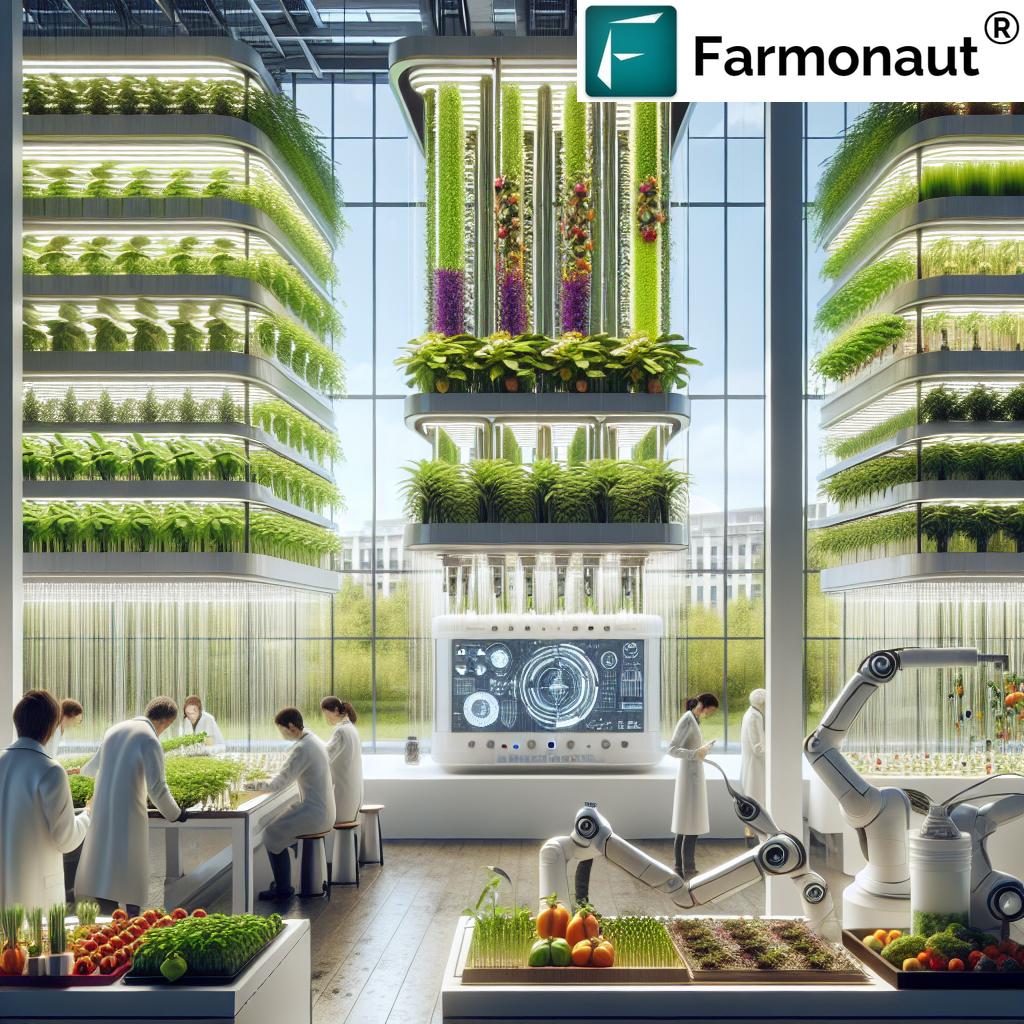
The Circular Bioeconomy: Closing the Loop
A key concept in the USDA’s plan is the promotion of a circular bioeconomy. This approach aims to minimize waste and maximize resource efficiency by reusing, recycling, and upcycling biological materials. The circular bioeconomy encompasses:
- Converting agricultural waste into value-added products
- Developing biodegradable alternatives to single-use plastics
- Creating closed-loop systems in food production and processing
- Implementing regenerative practices that enhance soil health and biodiversity
By embracing these principles, the agricultural sector can significantly reduce its environmental impact while creating new economic opportunities. Farmonaut’s carbon footprint tracking feature helps agribusinesses monitor and reduce their environmental impact, aligning perfectly with the goals of a circular bioeconomy.
Agricultural Research and Development: Driving Innovation
The USDA’s plan recognizes the critical role of research and development in advancing the bioeconomy. Significant investments are being made in various areas of agricultural innovation, including:
- Genomics and biotechnology for crop improvement
- Advanced fermentation and bioprocessing techniques
- Nanotechnology for precision agriculture and food packaging
- Artificial intelligence and machine learning for farm management
These research efforts are not only enhancing productivity and sustainability but also creating new products and processes that can drive economic growth. Farmonaut’s commitment to innovation aligns with this focus, as we continuously refine our AI and machine learning algorithms to provide more accurate and actionable insights to farmers.
The Role of Government Policy in Shaping the Bioeconomy
The success of the USDA’s plan relies heavily on supportive government policies. Key policy initiatives include:
- Tax incentives for biobased product manufacturers
- Grants and loans for farmers transitioning to sustainable practices
- Research funding for universities and agricultural research centers
- Regulatory frameworks that promote innovation while ensuring safety
These policies create an enabling environment for the bioeconomy to flourish, encouraging investment and innovation across the agricultural sector. While Farmonaut operates independently of these policies, we support initiatives that promote sustainable and technologically advanced farming practices.
Challenges and Opportunities in the Bioeconomy Transition
While the potential of the bioeconomy is immense, the transition is not without challenges. Some key issues include:
- Balancing food production with biomass for industrial use
- Ensuring the economic viability of new biobased products
- Addressing potential environmental impacts of increased biomass production
- Overcoming technological and infrastructural barriers
However, these challenges also present opportunities for innovation and collaboration. By addressing these issues head-on, the agricultural sector can emerge stronger and more resilient. Farmonaut’s technologies, such as our blockchain-based traceability solutions, can play a crucial role in addressing some of these challenges by enhancing transparency and efficiency in supply chains.
The Global Context: America’s Role in the International Bioeconomy
The USDA’s plan positions the United States to be a leader in the global bioeconomy. This leadership role involves:
- Setting international standards for sustainable biomass production
- Fostering collaborations with other nations on bioeconomy research
- Expanding export markets for US biobased products
- Sharing best practices in precision agriculture and sustainable farming
By taking a proactive role on the global stage, the US can not only boost its own agricultural sector but also contribute to addressing global challenges like climate change and food security.
The Future of Farming: Integrating Technology and Sustainability
As we look to the future, it’s clear that the integration of technology and sustainability will define the next era of agriculture. The USDA’s plan sets the stage for a farming sector that is:
- Data-driven and technologically advanced
- Environmentally sustainable and climate-resilient
- Diverse in its product offerings and market opportunities
- Supportive of thriving rural communities
Farmonaut is proud to be at the forefront of this transformation, offering tools and insights that empower farmers to embrace this future. Our commitment to making precision agriculture accessible aligns perfectly with the USDA’s vision for a thriving, sustainable agricultural sector.
Explore Farmonaut’s API for developers: Satellite and Weather API
Learn more about our API: API Developer Docs
Bioeconomy Impact on US Agriculture and Rural Communities
| Bioeconomy Sector | Sustainable Agriculture Practice | Economic Impact | Environmental Benefit | Rural Job Creation Potential |
|---|---|---|---|---|
| Biofuel Production | Energy crop cultivation | $45 billion market by 2025 | 30% reduction in GHG emissions | 50,000 new jobs |
| Biobased Materials | Crop residue utilization | $100 billion market by 2030 | 40% reduction in plastic waste | 75,000 new jobs |
| Precision Agriculture Technology | Data-driven farming | 25% increase in crop yields | 20% reduction in water usage | 30,000 new tech jobs |
| Circular Bioeconomy Initiatives | Waste-to-value processes | $50 billion in new revenue streams | 50% reduction in agricultural waste | 40,000 new jobs in recycling and upcycling |
Conclusion: A New Chapter in American Agriculture
The USDA’s groundbreaking plan for boosting sustainable agriculture and the US bioeconomy marks the beginning of an exciting new chapter in American farming. By embracing sustainable practices, leveraging cutting-edge technology, and tapping into new market opportunities, the agricultural sector is poised for transformative growth.
As we’ve explored throughout this blog, the potential benefits are far-reaching:
- Enhanced environmental sustainability
- Increased economic opportunities for farmers and rural communities
- Advancements in agricultural technology and innovation
- Strengthened position in the global bioeconomy
At Farmonaut, we’re excited to be part of this journey, providing farmers with the tools and insights they need to thrive in this new era of agriculture. Our commitment to making precision farming accessible aligns perfectly with the USDA’s vision for a sustainable, technologically advanced agricultural sector.
As we move forward, it’s clear that the success of this initiative will depend on the collective efforts of farmers, researchers, policymakers, and technology providers. By working together, we can create a resilient, sustainable, and prosperous future for American agriculture.
FAQ Section
Q: What is the bioeconomy?
A: The bioeconomy refers to the part of the economy that uses renewable biological resources (such as crops, forests, animals, and microorganisms) to produce food, materials, and energy.
Q: How does the USDA plan to boost the bioeconomy?
A: The USDA plans to promote sustainable agriculture practices, invest in research and development, support biobased product manufacturing, and create resilient biomass supply chains.
Q: What are some examples of biobased products?
A: Biobased products include biofuels, bioplastics, plant-based textiles, biodegradable packaging, and bio-based chemicals used in various industries.
Q: How can farmers benefit from the growing bioeconomy?
A: Farmers can benefit through new market opportunities for biomass crops, increased demand for agricultural residues, and potential for value-added products from their existing crops.
Q: What role does precision agriculture play in the USDA’s plan?
A: Precision agriculture is crucial for optimizing resource use, improving yields, and reducing environmental impact, all of which are key goals in the USDA’s plan to boost sustainable agriculture.












